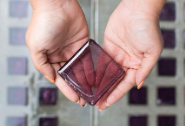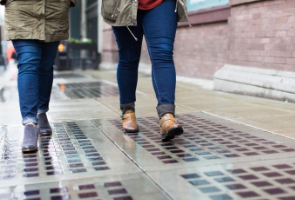The glass prisms found throughout Seattle’s Pioneer Square were built to provide natural light to the subterranean passages constructed below after the Great Fire of 1889. They’re an interesting feature to explore and are visible both above ground and on the Underground Tour.
Purple in color due to a reaction to UV light, the prisms let sunlight through the subterranean vaults. They’re also an important part of the historic fabric of the neighborhood.
History
When it came time to build Seattle’s original city, Pioneer Square was carved out of lush forestland alongside Elliott Bay. Despite this location, businesses in the area suffered from flooding and sewage backup due to tides.
The City decided to raise the street level in order to fix this problem. It took a while, but eventually, the city completed its plan, and by 1889, Pioneer Square was elevated a full floor above street level.
Alongside this elevation, the city also installed glass prisms that let light into basements and storage spaces beneath the sidewalks. The prisms were created by changing the shape of a glass block to a prismatic design, allowing it to reflect light more effectively.
These glass blocks were first introduced to the world at Chicago’s 1893 Columbian Exposition. Originally designed to increase light through window openings, they were later adapted for floors and sidewalks.
Today, these glass prisms can be seen throughout Washington in cities from Port Townsend to Tacoma. They are a unique feature of the urban landscape, but they are often heavily damaged or poorly maintained.
Thankfully, the National Trust is working with the Alliance for Pioneer Square to help restore these unique features in the neighborhood’s historic district. This effort is part of The Cities Project by Heineken, a crowd-funding campaign to restore ten public spaces in cities around the country.
In May 2017, the National Trust and the Alliance launched the campaign with a goal of raising $40,000 to support restoration efforts for the prisms. That work continues on today as more owners look to recapture the historic beauty of the past.
One of the biggest challenges was empowering the property owners in the district to effectively steward, repair, and maintain the character-defining prisms. Creating a resource guide to assist property owners in efficiently repairing and preserving the historic glass sidewalks has been a major focus of this project. Please see the link below.
The manual covers everything from the history of the prisms to their materials, installation, and refracting systems to the tools and techniques to use when repairing them. In addition, it will offer technical assistance to help property owners identify and prioritize areas of concern. PIONEER SQUARE GLASS PRISM MANUAL
The sidewalks adjacent to Smith Tower and many other Pioneer Square landmarks are checkered with thousands of small squares made from prism glass. These prisms are skylights that once served a practical purpose to illuminate the underground areaways that once connected street level with the basements of Seattle’s buildings.

The prisms are built into sidewalk panels using methods that were common in the 19th century. Some are constructed from cast iron, while others use prefabricated precast concrete panels with reinforcing bars.
They’re a great way to increase the amount of natural light in a space without using electricity, and they can be a key part of the architecture of a building. They’re also easy to repair and maintain, making them a smart choice for property owners.
When they’re in good condition, prisms can create a natural glow on the sidewalk that’s beautiful and useful. They’re particularly suited for areas that don’t get much natural sunlight, such as basements, because they can act as a source of illumination both day and night.
The restoration of these prisms is a labor-intensive process. However, the results are worth the effort. If you are looking for a replacement panel, Circle Redmont has some excellent prefabricated panel and glass options.
Historically, the prisms were fabricated from glass and were installed in cast iron framing systems. They were then protected by waterproof caulking or grout, depending on their location.
There are over 11,000 prisms in Pioneer Square, and they are a defining part of the neighborhood’s history. With the help of the Alliance for Pioneer Square and the National Trust, we’re going to work hard to make sure these prisms remain beautiful and functional for generations to come.
Contact Circle Redmont
Contact us today @ 800-358-3888.



